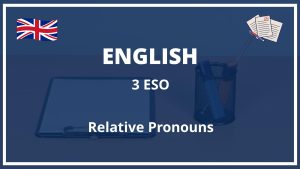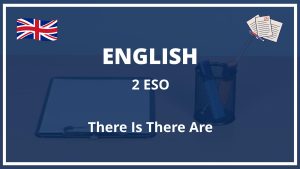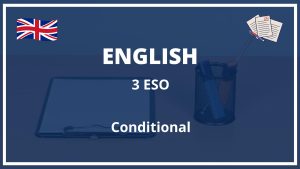
Abrir Ejercicios Relative Clauses 4 ESO | Exercices
A relative clause is a clause starting with a relative pronoun (or a relative adverb) which refers back to a noun or pronoun used earlier in the sentence. The relative pronoun (or adverb) acts as a link between the two parts of the sentence and gives extra information about the noun or pronoun.
There are three relative pronouns in English: who, whom, whose; that; which. We use who/whom to refer to people and that/which to refer to things. We use whose to show possession. The relative pronoun can be the subject or the object of the verb in the relative clause.
Here are some examples:
The man who/that/whom I saw in the park was my brother. (= My brother is the man I saw in the park.)
The book that/which I bought yesterday is very interesting. (= The book I bought yesterday is very interesting.)
The house whose windows are broken is empty. (= The house whose windows are broken is empty.)
The relative pronoun can also be omitted, especially when it is the object of the verb. This is called an ‘elliptical relative clause’.
Here are some examples:
The man I saw in the park was my brother. (= The man who/that I saw in the park was my brother.)
The book I bought yesterday is very interesting. (= The book that I bought yesterday is very interesting.)
The house whose windows are broken is empty. (= The house whose windows are broken is empty.)
We can use relative clauses to give extra information about a noun or pronoun. We can use them to give extra information about people, things, places, times and situations. Relative clauses usually go after the noun or pronoun they refer to.
Here are some examples:
I live in a small town which is very beautiful. (= I live in a small town and it is very beautiful.)
I have a friend who comes from Australia. (= I have a friend and he comes from Australia.)
I was born in a hospital that no longer exists. (= I was born in a hospital and it no longer exists.)
We can use relative clauses to give extra information about a noun or pronoun. We can use them to give extra information about people, things, places, times and situations. Relative clauses usually go after the noun or pronoun they refer to.
Here are some examples:
I live in a small town which is very beautiful. (= I live in a small town and it is very beautiful.)
I have a friend who comes from Australia. (= I have a friend and he comes from Australia.)
I was born in a hospital that no longer exists. (= I was born in a hospital and it no longer exists.)
Ejercicios Resueltos Relative Clauses Ingles 4 Eso
Relative clauses are one of the most difficult things to understand in English grammar. But don’t worry, we’re here to help. This article will explain everything you need to know about relative clauses, with plenty of examples to help you along the way.
A relative clause is a clause that is used to modify a noun or pronoun. In other words, it provides additional information about the noun or pronoun. For example:
The man who stole my car is in jail.
In this sentence, the relative clause «who stole my car» modifies the noun «man.» It provides additional information about the man: specifically, that he stole the speaker’s car.
Relative clauses can be either defining or non-defining. A defining relative clause is essential to the meaning of the sentence; without it, the sentence would not make sense. A non-defining relative clause, on the other hand, is not essential to the meaning of the sentence; the sentence would still make sense without it.
Let’s look at an example of a defining relative clause:
The woman who is standing next to the bank is my sister.
In this sentence, the relative clause «who is standing next to the bank» is essential to the meaning of the sentence. Without it, we would not know which woman the speaker is talking about. The sentence would simply be:
The woman is my sister.
Now let’s look at an example of a non-defining relative clause:
My sister, who is standing next to the bank, is a doctor.
In this sentence, the relative clause «who is standing next to the bank» is non-defining. It provides additional information about the sister but is not essential to the meaning of the sentence. The sentence would still make sense without it:
My sister is a doctor.
As you can see, defining relative clauses are always placed immediately after the noun or pronoun they modify, while non-defining relative clauses are set off from the rest of the sentence with commas.
Now that you know the difference between defining and non-defining relative clauses, let’s take a closer look at how they’re constructed.
Relative clauses are always introduced by a relative pronoun or a relative adverb. The most common relative pronouns are «who,» «that,» and «which.» For example:
The man who stole my car is in jail. The car that he stole is a BMW. The police are looking for the witnesses which saw the crime.
The most common relative adverb is «where.» For example:
This is the bank where the woman was standing.
Now let’s put everything we’ve learned into practice with a few exercises.
Exercise 1: Complete the following sentences with a relative pronoun or adverb.
1. I live in the house _________ my parents live.
2. This is the restaurant _________ we ate last night.
3. The man _________ I spoke to on the phone was very rude.
4. I’m looking for a job _________ I can use my skills.
5. Do you know the woman _________ is standing over there?
Answers: 1. where 2. where 3. who 4. where 5. who
Exercise 2: Complete the following sentences with a defining or non-defining relative clause, as appropriate.
1. My sister _________ is a doctor works at the hospital.
2. The man _________ stole my car has been caught by the police.
3. I live in the house _________ my parents live.
4. This is the restaurant _________ we ate last night.
5. The car _________ he stole is a BMW.
Answers: 1. who 2. who 3. where 4. where 5. that
We hope you found this article helpful. If you have any questions, please feel free to ask in the comments section below. And be sure to check out our other articles on English grammar.








